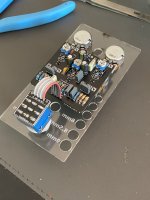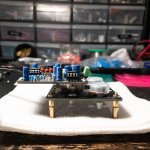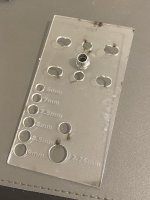giovanni
Well-known member
Today I laser cut a very handy jig to assemble PedalPCB boards (per other thread, huge credit to @Robert for standardizing pot placement) and I find it very very useful. I’m happy to share the svg if you’re interested. Here’s a pic:

Besides following the drill template for all PPCB enclosure types, I also made holes of various sizes to test things like LED bezels and what not. I don’t know that I’ll ever need it but I thought it would be good to have.

Besides following the drill template for all PPCB enclosure types, I also made holes of various sizes to test things like LED bezels and what not. I don’t know that I’ll ever need it but I thought it would be good to have.




